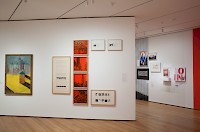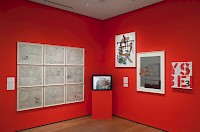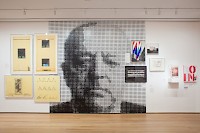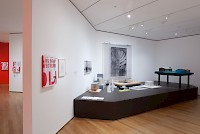An ardent question haunting architectural practice and urbanism is how can alternatives to official urban planning improve living conditions in mega-cities, facing deficit laws, unclear legal issues, lack of funding, discrimination and disfavored communities? Art, design, architectural practice have been recently called to work in situ in various smaller or larger scale projects, with the main strategy of finding solutions from with-in. Not associated with permanency, this agile architecture is meant to evaluate and reflect on historic circumstances and to involve the differentiated communities themselves in city planning.
Pedro Gadanho, currently curator at MoMA's, Architecture and Design Department, has been in his manifold career to date an advocate of performance-architecture. In his blog Shrapnel Contemporary, he recalls having first started to project an exhibition on this theme in 2007. It materialized in 2012 at the Guimaraes Capital of Culture in Portugal. Characterized by a specific temporality, in which fast solutions reflect on the fast changing city, performance-architecture for him must be collective, radical and transitory. Himself an architect (note for example his vividly colored, subtle, tactile spaces of the family houses in Porto and Torres Vedras in Portugal), performativity in architecture is understood by him “as a critical answer to the results of growing mobility in the recent neo-liberal context: (…) tactics for “activation” of the local potential for social change”.1
Uneven Growth: Tactical Urbanisms for Expanding Megacities, opening at MoMA in November 22 this year and now in preparation, follows in practical terms these preoccupations of its curator Pedro Gadanho. This project, conceived on manifold levels (workshops, conferences, a publication and an exhibition) seems to represent a double challenge: first as a investigative curatorial approach, which started to be adopted only recently at MoMA and secondly as an opportunity to test the concrete agency of a performative and incisive architectural practice.
In another article published even earlier in 20062, Pedro Gadanho relates the term performance-architecture to another concept – open source architecture – that reflects on the capacity of architecture to metamorphose, adapting to immediate needs in an everyday context. An anticipation of it, could be considered for example the contemporary 'vernacular architecture', which develops responses to the traditions and needs of the immediate cultural and local context it is placed in. But in Pedro Gadanho's view, these previous attempts have tended to be codified by the discipline and ended up being absorbed as autonomous author-works. Therefor a new need manifests to follow, curate, theorize “open source architecture, as a phenomena that: coming from the margins of the established contemporary system of architecture, is deeply involved with various cultures present in the cities and metropolises of our day (…) and is open for appropriation by urban practitioners such as artists and designers.” (Pedro Gadanho, interview)3
Architect, author, professor, blogger, Pedro Gadanho has been appointed in 2011 curator at MoMA, where he kindly received me for a small discussion on his upcoming projects at the Architecture and Design Department: an exhibition with MoMA's recent acquisitions (Conceptions of Space: Recent Acquisitions in Contemporary Architecture, July 4–October 19, 2014) followed by Uneven Growth: Tactical Urbanisms for Expanding Megacities, from November 22, 2014–May 10, 2015.
Uncovering two approaches to curating architecture, one based on collecting and preserving 'evidences' of material culture, the other one process-oriented and rather experimental, the two exhibitions nuance – each in its particular way – these distinctions. Conceptions of Space, is entirely constituted of MoMA'a Architecture and Design past two year's acquisitions bringing together 20 projects, some acquired, other offered by donors or architects. Nevertheless, the display of acquisitions is converted in this show into a reflection on collecting as a curatorial practice, while not only finite objects, but also interpretative material and ephemeral hypostasis of these architectures, are called to built up the discipline (for example the performative approach of Jimenez Lai and the “Romance of System” video of the MOS architectural office).
“They are revealing not only the direction of what we are collecting here in terms of contemporary architecture, but also changes in the way we are collecting. As a free lance curator, I was defining themes or trying to analyze emerging phenomena. I was working towards producing new work, or joining works, that had not been connected before. When you work with a collection you may have the same approach, which is to think about certain themes, but you have to use the work that is already in the collection – an approach which is also very interesting and challenging. When I did 9 + 1 Ways of Being Political: 50 Years of Political Stances in Architecture and Urban Design (MoMA, September 12, 2012–June 9, 2013), I was picking up projects that could illustrate or demonstrate how the work of the architect is political. It was very interesting to navigate from the 60's to today and reveal how these works could be read as political. Looking at the British architecture group Archigram for example, I was understanding their project Walking City as a political statement, rather than just a radical avant-garde position. With Cut 'n' Paste: From Architectural Assemblage to Collage City (MoMA, July 10, 2013–January 5, 2014), the second exhibition that I have done at MoMA, I was again addressing a more disciplinary issue, the idea of collage and how can this typical avant-garde artistic methodology get appropriated by architects and how it produced new visions and reflections in architectural history.”(Pedro Gadanho, interview)4
Lately collected projects by Herzog & de Meuron, Álvaro Siza, Kengo Kuma, Pezo von Ellrichshausen, Ryue Nishizawa, Ensamble Studio and the New York-based SO-IL and MOS Architects chart, in various media, the transforming position of the subject in relation to space and its roots in the critical thinking of the last decades. In this sense, architecture is not limited to habitation, but functions as a conceptual approach in a broader range of practices. Pedro Gadanho talks5 about a newly acquired piece by Marjetica Potr, a visual artist trained in architecture and based in Ljubljana, Slovenia, whose perception of architecture through a sociological lens (as connected to the city life) is for him paradigmatic in this sense.
Architecture as a result not only of practice, experience and matter, but also as a fictive dimension has been a constant 'theme' in Pedro Gadanho's past work. The imaginary ingredient of architecture (the intellectual, sensible and projective response of its users) is what surpasses and extends the limits of the possible, but it nevertheless is a constitutive part of architecture, part of its essence. Associated to the Lisbon Architecture Triennale, Pedro Gadanho co-organized in 2010 the 1st International Conference on Architecture and Fiction: Once Upon a Place – Haunted Houses and Imaginary Cities (2010), which explored a visionary, utopian dimension of architecture. One of its platforms 'Does form Follow Fiction?' rose questions on the anticipatory dimension of utopia and fiction in architecture and on how do literary and visual narrations shape future popular culture and practice.
9 + 1 Ways of Being Political: 50 Years of Political Stances in Architecture and Urban Design (curated by Pedro Gadanho in September 12, 2012–June 9, 2013) reloads these preoccupations in the sense of reading the utopian/fictional dimension of architecture through an emerging political approach in architecture. Having assimilated the 1960's anarchic movements, new ways of reacting are in this exhibition traced historically, from the 1970s utopian visions expressing a new social and urban critique to strategies emerging from the present global power structures.
Fiction, urbanistic projection and creative solutions are also the gear of the closing exhibition of 2014, Uneven Growth: Tactical Urbanisms for Expanding Megacities, (November 22, 2014–May 10, 2015), this time not as a documentary and historically oriented practice, but as an agency for finding specific urbanistic solution in no less than 6 mega-contexts: Hong Kong, Istanbul, Lagos, Mumbai, New York, and Rio de Janeiro – a big challenge at MoMA6. 12 interdisciplinary teams of researchers and practitioners examine locally urbanistic potential, while proposals for various social contexts in each of these cities, result from collaborations between a local and an international team. A row of workshops in MoMA PS1, in Shenzen in China (during the Shenzen Biennial) and in Vienna have prepared and communicated findings of this complex process. Inequality, social justice, spatial justice are intended to be addressed and master plans questioned, while searching for bottom-up strategies.
Pedro Gadanho relaunches here his preoccupations with architectural practice as integrating informality and what he calls (in plural): tactical urbanisms (locally devised, constantly transforming solutions). He explains7 that
“Contrary to previous exhibitions on urbanism (for example the Century City in London at the Tate Modern, 2001, based on data collection and statistics), this exhibition is projective, designing near future scenarios and reacting to them. This approach is intended to favor smaller initiatives, provoking architects to engage with the future of the city and facilitating for the citizen to take into their own hands urban development”.
Nevertheless previous or concomitant projects have risen similar questions. The recent WELTSTADT, a project sustained by the Goethe Institute has spanned 16 cities, involved local researchers, activists and architects and tried not only to stimulate and implement solutions, but also to identify already existent survival strategies, that local communities always develop in a crisis driven ambient. WELTSTADT and similar projects have risen important questions in the field: the need to valorize and support the solutions that are developed on an every-day basis by families and communities, using the existent resources and historic knowledge, rather than implementing design solutions and searching for 'lab-produced' architectural innovative devices that finally might not be absorbed, beyond the timespan of a 'creative workshop'. Unspectacular, discreet informal solutions which generally emerge in affected communities are often the most effective – as an interplay of mutually influencing factors. These locally concocted solutions are always manifold, creative and innovative in any crisis–affected community. Uncovering local knowledge and exposing it publicly are a priority, which can activate from within progressive solutions and a critical and participative action-taking.
Uneven Growth works on a tandem basis: international and local teams are invited to work together: in New York the Situ Studio, New York, US and Cohabitation Strategies (CohStra), Rotterdam, Netherlands. In Rio de Janeiro:Rua Arquitetos, Rio de Janeiro, Brazil and MAS Urban Design ETH, Zurich, Switzerland. In Mumbai:URBZ, Mumbai, India and Pop Lab, Massachusetts Institute of Technology (MIT), Boston, US. In Lagos: NLE Architects, Lagos, Nigeria and Inteligencias Colectivas, Madrid, Spain. In Hong Kong the MAP Office, Hong Kong, China and the Network Architecture Lab, Columbia University, NY, US. In Istanbul: Superpool, Istanbul, Turkey and Atelier d’Architecture Autogérée, Paris, France.
The teams corroborate insights from the domestic space, the suburban and the polis, considering the contradictory aspects of late capitalism, and the resulting diversity and disorder on urban level in the chosen mega-cities. Presenting their insights on the way in workshop format, they suggest solutions and a try to built up a responsible attitude in front of what is perceived as a local deficit.8 The project has an impressive advisory board, including Saskia Sassen, David Harvey, Ricky Burdette, Neil Brenner, Nader Tehrani, Michael Sorkin, Marc Angélil, Teddy Cruz, while David Harvey, Sakia Sassen, Ricky Burdett and Teddy Cruz are some of the contributing authors to the project's publication, now in preparation9.
As the complex outcomes of the stages of Uneven Growth are not disclosed yet, we can only rise some question regarding presumable challenges: the social consequences, generated by the appearance of new relations – between project initiators, the experts and the affected community, between the local supporters and the detractors of the project. The fine line between assuring support and advice and interceding in a certain context, can have also temporal consequences (as for example leading to an acceleration of gentrification processes) and therefor can only benefit from a critical self–monitoring. The informal practices and local knowledge resulting from the gap between the rapid pace of change in cities and the often not adjusted urbanistic laws, is on the other hand, a body of information, which can be seen as the materia prima of any research and proposal, and which often is engulfed by illegality.
How do all these questions risen by a project of such extent, reflect back on the institution's own discursive scaffold?
“Over the last years I think there was a shift in terms of collecting at MoMA: from a previous object based approach, to reflecting the evolution of a project and revealing more of its aspects. The MoMA strategy over many, many years was to collect representative objects, iconic models that would simulate a project in a very distant way. What we are now trying to do is to identify a cluster of objects (drawing, sketches, videos, digital material) that can explain phenomena, rather than delineating a singular work. These two upcoming exhibitions10 will try to show this new approach and to follow the manifold representations and messages of architecture today, which should reflect also in our collection. MoMA's collection is foremost an opportunity to put artistic and architectural works in dialogue, which I especially enjoy. Question of interdisciplinarity, in which I have been always interested in regard to architecture, have in this way also come back into my preoccupations.“(Pedro Gadanho, interview)11
Marta Jecu





